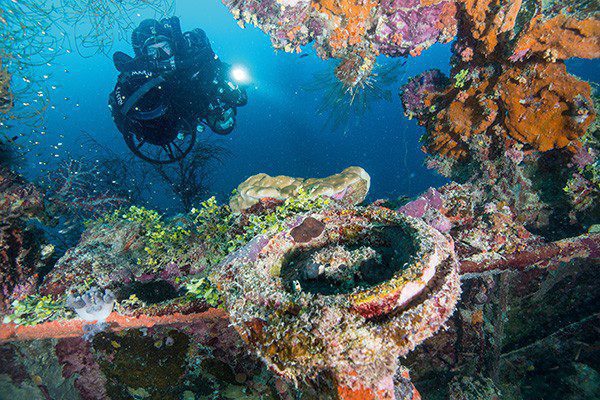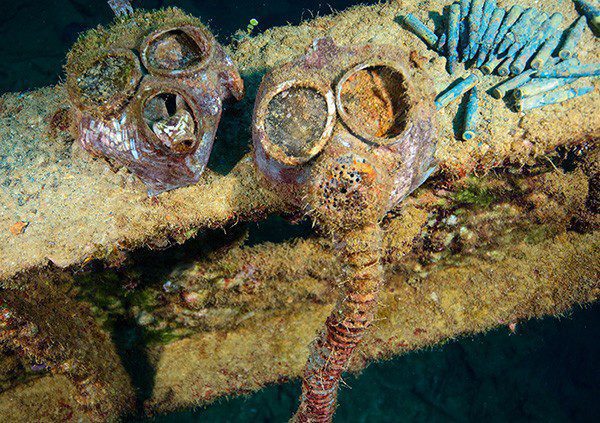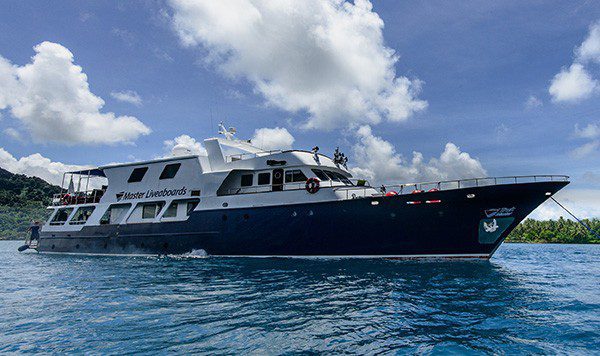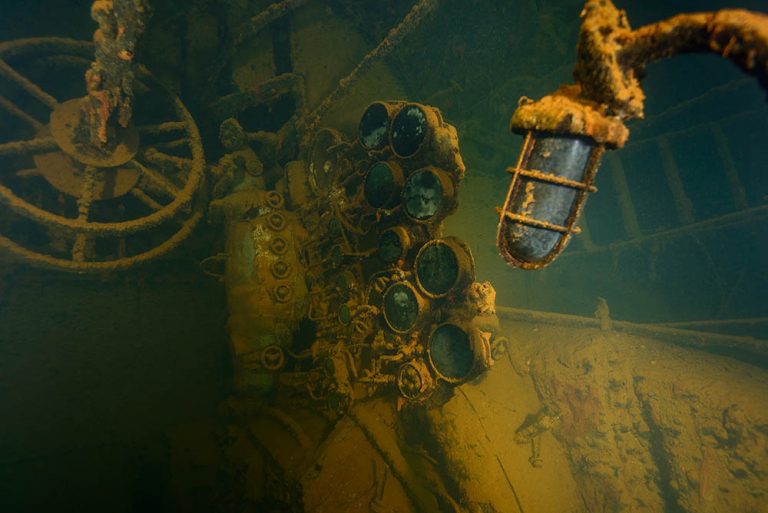Today every square centimetre of the globe can be inspected from satellites, but during WW2 the Imperial Japanese Navy managed to hide most of its Pacific fleet inside a fortified atoll in Micronesia. When US Forces discovered the truth about Truk Lagoon, it was game over – yet the violent strike took the Japanese completely by surprise. In the first of a two-part feature, JESPER KJØLLER reports on the action and its incredible legacy
EVER SINCE WATCHING Jacques Cousteau’s documentary Lagoon of Lost Ships when I was a kid, I had wanted to visit the place, so far from my native Denmark. Thousands of wreck-dives later, and 25 years after being certified as a diver, I finally find myself in Truk Lagoon for the first time.
I want to start the adventure well-rested and fine-tuned to the Pacific time-zone, so having arrived at the small airport on Weno, I plan to adjust my jet-lag at Blue Lagoon Resort, where I have booked two nights before boarding the Truk Master.
The road from the airport to the resort is in poor condition, but the scenery is exotic. Women walk along the road in colourful outfits with flowers in their hair, as if they have just stepped out of a Gauguin painting.
Strangely, the cars all seem to have right-hand steering, yet they don’t drive on the left here. Perhaps that’s why so many cars lie wrecked beside the road?
Blue Lagoon Resort is a somewhat shabby lodge with a very laidback service concept. However, it is said to be the best resort on the island. I remind myself that Truk is a poor and remote location, and I spend most of the two days in the resort reading up on the historical background of the adventure that lies ahead of me.
Secret fortification
There were already ties between Japan and Truk in the late 19th century, when Japanese seafarers began visiting the islands inside the enormous atoll. After World War One, Japan was formally awarded a mandate to govern Micronesia as part of the Treaty of Versailles.

Japanese expatriates settled on the islands and developed the infrastructure. The two cultures blended, with inter-racial marriages not uncommon, a fact evident today in the locals’ facial features and names.
As Japan became increasingly militarised in the 1920s and ‘30s, naval officers recognised the advantages of the sheltered lagoon, and secretly turned Truk into a fortified stronghold.
The lagoon was ideally situated halfway between Hawaii and the Philippines, and Truk became Japan’s principal naval supply station for both commercial and military operations in the Pacific theatre.
The military reinforcement of the lagoon was in direct violation of the Treaty of Versailles, but the Japanese managed to carry out the fortification in utmost secrecy, and no foreigners were allowed to visit the area.
Knowledgeable crew
I leave terra firma to board the Truk Master. It’s a stark contrast to the weary resort – on the boat everything is clean, effective and streamlined. The local crew-members are very friendly, helpful and speak excellent English, and the liveaboard is roomy, with large cabins and plenty of space for cameras and gear.
The satellite-based wi-fi on the boat is probably the fastest and most reliable in Micronesia. However, it’s expensive to use, so it’s wise to keep your Internet time to a minimum – or get off the grid completely for a while.
The boat is captained by the experienced British skipper Martin Cridge, an enthusiastic wreck-diver, and our 10-day trip is led by the young but very competent Cruise Director Aron Arngrímsson from Iceland. Martin and Aron’s combined extensive knowledge of the wrecks and their enthusiasm for Truk adds an extra dimension.
In addition, the local dive-guides on Truk Master know every nook and cranny of the wrecks – they have literally grown up on them.
The boat has a nice reference library in the saloon, so after setting up my equipment and camera I continue my studies of Operation Hailstone while waiting for the trip to commence.
Sitting Duck
The Americans suspected that Truk Lagoon was used as a Japanese anchorage, but they had no idea of the massive scale of the military operation inside the lagoon. More than 40,000 Japanese civilians lived and worked on Truk. More than 1000 war and supply ships were moored there, and a total of five airfields supported close to 500 aircraft.
Among the vessels were battleships, cruisers, submarines, aircraft-carriers and, in addition, a huge number of auxiliary vessels, supply ships and tenders.
As the war progressed, the Allied forces gradually came closer and closer. Early in February 1944, the lagoon was overflown by two American PB-4Y Liberator reconnaissance aircraft from a base in the Solomon Islands.
The Japanese tried to shoot down the spy planes, but the American pilots managed to escape, with revealing recce photos. The secret was out. The US generals immediately started planning an air-raid from aircraft-carriers. Operation Hailstone was conceived.
The Japanese commanders, realising that Truk was a sitting duck, decided to evacuate the more valuable warships to another base in Palau. But many cargo vessels stayed behind, and others were still incoming, not knowing that their cover was blown.
Some of the ships were unable to move because they were under repair, or in the middle of off-loading cargo. There was also a shortage of fuel.
A few vessels were empty, but many had holds and decks packed with tanks, mines, artillery, land vehicles, aviation spare parts, fuel and other supplies for the Japanese war machine.
Still lifes
After a few warm-up dives, it’s time to dive the mighty Shinkoku Maru, which is completely encrusted with soft and hard corals. The superstructure is so overgrown with marine life that the wreck took an extra-hard beating during the hurricane of March 2015. The additional weight from the corals made the funnel collapse in the rough weather.
There is so much nature to be enjoyed on Shinkoku that you almost forget that this is a reef of metal. Everywhere, clouds of glassfish swarm in the shadows between huge branches of soft coral. Every square centimetre is covered with corals or huge sea anemones with their clownfish. The railings of the vessel are invisible behind all the growth.
A grey reef shark follows us from a distance, and the local turtle peeks out from one of the holds and swims away slowly.
With so much life, it’s no wonder that Shinkoku Maru is a popular night-dive.
But if for a moment you should forget that you’re diving a renowned WW2 shipwreck, you’re reminded of that reality when you navigate through the explosion hole in the starboard side, and wriggle into the huge engine-room.
The lower parts are quite narrow, and require a guide who knows the route well. The upper part of the engine-room, on the other hand, is an enormous cathedral with a dim shimmer of light that penetrates through the skylight at the top.
Up on the deck, which is at around 18-20m, there are plenty of details to enjoy. Partly covering the dial of the stern machine telegraph sits a white sea anemone complete with a small resident anemonefish.

It’s tempting to describe Truk Lagoon as the world’s largest underwater museum, but someone has misunderstood the concept a bit. I assume it is well-meaning local dive-guides who have arranged the line-ups of artefacts so typical of Truk.
On most wrecks, you’ll see still-lifes of bottles, porcelain, boots, ammunition, gas-masks, cookware and all kinds of knick-knacks neatly arranged in photogenic positions.
A more naturalistic approach would convey a better impression of life on board, but I’m sure these arrays were put together with good intentions.
Inside the superstructure, we swim into the infirmary, complete with operating table. Someone has arranged an assortment of large bones on the table, but I seriously doubt if they are human.
On the bridge, there are no fewer than two intact machine telegraphs and a nice compass-housing, but the bridge is swarming with so much fish-life that it’s almost impossible to take pictures.
I’m only a few dives into the trip, but I’m inclined to nominate Shinkoku Maru as my preliminary favourite. Its combination of all the intact maritime hardware, the impressive marine life and the cathedral-like engine-room will be hard to beat.
The historic setting is what makes the dives on Truk unique, and I dive back into the history-books while off-gassing before the next dive.
One-sided battle
On 16 February, 1944, a powerful US naval assault force consisting of cruisers, battleships, aircraft-carriers, patrol subs and supply and support vessels approached the lagoon undetected.
The fact that the Japanese had evacuated the heavy warships made Truk far more vulnerable, and even if the Imperial Japanese forces suspected a forthcoming attack, they were still caught off-guard when Operation Hailstone began at sunrise the following morning.
Grumman F6F Hellcat fighter planes swept over the lagoon, wiping out the Japanese air power.
At the beginning of the war Zero fighters had outclassed Allied fighter planes, but they were no match for the new, powerful Hellcats, and the Japanese pilots were young and inexperienced.
The air attack on Truk was so swift and forceful that it resembled the Japanese strike on Pearl Harbor in 1941. It was payback time.
Many Japanese planes never got airborne – they were demolished on the ground. Others were shot down as they lifted off, or during short, violent dogfights with the Hellcats.
The US forces established control of the airspace over the lagoon in just a few hours, and soon began to launch wave after wave of bombers to attack the now-vulnerable cargo ships as well as the land installations.
Throughout the rest of 17 February and into the 18th, Douglas Dauntless, Grumman Avenger and Curtiss Helldiver bombers dropped their lethal payload on the defenceless Japanese fortifications and cargo vessels. It was a one-sided battle.
Operation Hailstone resulted in the Japanese losing three light cruisers, four destroyers, eight smaller warships, 32 merchant vessels and approximately 275 aircraft.
Nature takeover
From the beginning, the dive operators in the lagoon have been aware of the importance of guarding the underwater treasures that attract the visitors. Good care has been taken to protect the wrecks against pillaging.
When leaving the islands, one’s baggage is likely to be thoroughly searched (I was told that there is no X-ray machine at the airport). If you get caught with any relics from the wrecks in your luggage, you risk a fine of US $10,000, or even a jail sentence.
Inevitably, some articles have disappeared over the years. However, there are still so many interesting objects on board the vessels that there is plenty for everyone to appreciate in situ.
After 73 years at the bottom, the ships are slowly breaking down. One thing is the corrosion, which naturally sets its mark and over time obliterates the metal, but the extensive coral colonisation also helps to blur the contours and details, especially on the shallower wrecks.
In many places the wrecks are so encrusted with corals that you need a good imagination (and a solid knowledge of maritime architecture and function) to understand what you’re looking at. I kind of like it.
There is something encouraging about seeing how the underwater flora and fauna reclaims its space, given enough time. It’s like watching the roots of a big tree squeezing through a thick layer of asphalt. Sooner or later, nature’s takeover in Truk will be complete.
The smell of gasoline
After the war, nobody paid any attention to the Japanese ships on the bottom of the lagoon. The world tried to heal the wounds after World War Two, and hardly any salvage efforts were launched.
The locals in Truk had to deal with the toxic reality of the war of which they never wanted any part. Many of the ships were leaking oil and aviation fuel in significant quantities. Even today, the smell of gasoline is evident above the surface on a few of the wrecks.
Life on the islands just continued, and the abandoned military installations either found a civilian purpose or were just left to decompose as nature took over.
The wrecks were forgotten. And soon Truk was also forgotten.
Until a certain French underwater explorer turned up 25 years later…
Next month Jesper Kjøller continues to explore modern-day Truk, while tracing the footsteps of Jacques Cousteau.
Lagoon of lost ships – Rusty Pilgrimage to Truk Pt 2
PANELS
CHUUK or TRUK?
Chuuk has been the correct and current name to use since Federated States of Micronesia (FSM) was formed in 1979. Chuuk means “mountain” or “mountainous” in the local tongue. Using Truk is like calling Sri Lanka Ceylon, or Thailand Siam. However, the place was called Truk during the war, and also when the wrecks were rediscovered by the Cousteau team in 1969 – and, crucially, Truk Lagoon remains a well-known brand all over the diving world.
TRUK MASTER

The newest liveaboard in the region, Truk Master takes up to 16 guests on seven- or 10-night trips in the lagoon, plus occasional trips to Bikini Atoll. Given the long-distance travel, time difference and sheer amount to see, 10-night trips are strongly recommended. The vessel has four decks providing space for relaxation, dive equipment and camera preparation, and caters for technical divers on open- and closed-circuit, Master Live Aboards Website

